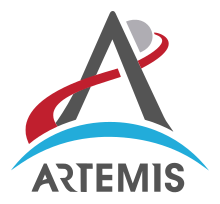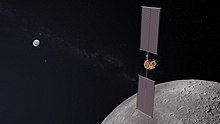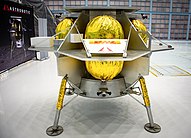
The Artemis program is a human spaceflight program by the United States. The Artemis program is intended to reestablish a human presence on the Moon for the first time since Apollo 17 in 1972; mid-term objectives include establishing an international expedition team, and a sustainable human presence on the Moon. Long-term objectives for Artemis are laying the foundations for the extraction of lunar resources, and eventually making crewed missions to Mars and beyond feasible.
To date, missions in the program are aimed at exploration of the Moon, including crewed and robotic exploration of the lunar surface. These explorations will be more focused towards areas such as the lunar poles and the far side of the moon. Three flights of the Orion Multi-Purpose Crew Vehicle are currently planned for launch in the Artemis program in the early 2020s, beginning with Artemis 1. Before Artemis was named, the flights were referred to as "Orion missions". Numerous supporting scientific and technology demonstration missions are planned for launch under the program's Commercial Lunar Payload Services (CLPS), in addition to planned and proposed uncrewed logistical missions to construct and resupply the Gateway and its expendable and reusable lunar landers in lunar orbit.
Main missions
[edit]| Mission | Launch date | Crew | Launch vehicle[a] | Launch pad | Duration[b] | |
|---|---|---|---|---|---|---|
| EFT-1 |
5 December 2014 | — Uncrewed mission |
Delta IV Heavy | Cape Canaveral Space Force Station, SLC-37B | 4h24m (success) | |
| Exploration Flight Test 1, high apogee high reentry test, carrying an uncrewed Orion capsule on its first spaceflight | ||||||
| Artemis 1 |
16 November 2022[1][2] | — Uncrewed mission |
SLS Block 1 Crew | Kennedy Space Center, LC-39B | 25.5d (success) | |
| Maiden flight of the SLS, formerly "Exploration Mission 1" (EM1), carrying an uncrewed Orion capsule and ten CubeSats selected through several programs.[3] The payloads were sent on a trans-lunar injection trajectory.[4][5] | ||||||
| Artemis 2 | April 2026[6] | SLS Block 1 Crew | Kennedy Space Center, LC-39B | ≈10d | ||
| First crewed flight, carrying four crew members on a circumlunar free-return trajectory. | ||||||
| Artemis 3 | Mid-2027[6] | TBA | SLS Block 1 Crew | Kennedy Space Center, LC-39B | ≈30d | |
| Carrying Artemis III mission hardware. First lunar landing of the Artemis program.[7] | ||||||
| Artemis 4 | September 2028[8][9] | TBA | SLS Block 1B Crew | Kennedy Space Center, LC-39B | ≈30d | |
| Second Artemis Lunar landing. Debut of the SLS Block 1B and the Exploration Upper Stage. Co-manifested delivery of the I-HAB module to the Lunar Gateway,[10][11] followed by a crewed lunar landing.[12] | ||||||
| Artemis 5 | March 2030[13] | TBA | SLS Block 1B Crew | Kennedy Space Center, LC-39B | ≈30d | |
| Co-manifested delivery of the ESPRIT Refueling Module to the Lunar Gateway.[14] | ||||||
| Artemis 6 | March 2031[13] | TBA | SLS Block 1B Crew | Kennedy Space Center, LC-39B | ≈30d | |
| Artemis 7 | March 2032[13] | TBA | SLS Block 1B Crew | Kennedy Space Center, LC-39B | ≈30d | |
| Artemis 8 | 2033 (presumed)[15] | TBA | SLS Block 1B Crew | Kennedy Space Center, LC-39B | ≈30d | |
| Artemis 9 (proposed) | 2034 (presumed)[16] | TBA | SLS Block 2 Crew | Kennedy Space Center, LC-39B | ≈30d | |
| Artemis 10 (proposed) | 2035 (presumed) | TBA | SLS Block 2 Crew | Kennedy Space Center, LC-39B | <180d | |
Support missions
[edit]Technology demonstrations
[edit]Launched on 28 June 2022,[17] the Cislunar Autonomous Positioning System Technology Operations and Navigation Experiment ("CAPSTONE") mission is a small (25 kg) technology-demonstration spacecraft designed to test a low-energy trans-lunar trajectories and to demonstrate the near-rectilinear halo orbit (NRHO) intended to support lunar polar missions.[18]
Surface missions
[edit]The Commercial Lunar Payload Services (CLPS) program will support the Artemis program by landing several small payloads focused on scouting for lunar resources, in situ resource utilization (ISRU) experiments and lunar science, in preparation for an extended human presence on the lunar surface.[19][20][21]
| Mission | Launch date | Operator | Lander | Rover | Launch pad | Launch vehicle[a] | Duration[b] | References |
|---|---|---|---|---|---|---|---|---|
| Peregrine Mission One | 8 January 2024 | Astrobotic | Peregrine | Iris | Cape Canaveral, SLC-41 | Vulcan Centaur | 10 days (failure) | [22] |
| The lander carried multiple payloads, with a total payload mass capacity of 90 kg.[23] However, the spacecraft was unable to reach the moon because of a propellant leak. It burned up over the Pacific Ocean on 18 January.[24] | ||||||||
| IM-1 | 15 February 2024 | Intuitive Machines | Nova-C | Kennedy Space Center, LC-39A | Falcon 9 | 7 days | [25] | |
| The lander carried six NASA-sponsored instruments, as well as six payloads from other customers, including EagleCAM.[26] The Odysseus lander successfully touched down at Malapert A near the lunar south pole on 22 February 2024.[27] The mission ended after 7 days with the onset of lunar night, after which no further signals from the spacecraft were received.[28] | ||||||||
| Blue Ghost M1 | 15 January 2025 | Firefly Aerospace | Blue Ghost | Kennedy Space Center, LC-39A | Falcon 9 | enroute (≈2 weeks) |
[29][30][31] | |
| The Spacex Falcon 9 rocket with the Blue Ghost lander successfully launched on 15 January 2025.[32] | ||||||||
| IM-2 | 27 February 2025 | Intuitive Machines | Nova-C | Kennedy Space Center, LC-39A | Falcon 9 | [33] | ||
| Griffin Mission One | September 2025 | Astrobotic | Griffin | Kennedy Space Center, LC-39A | Falcon Heavy | ≈100 Earth days | [34][35] | |
| IM-3 | October 2025 | Intuitive Machines | Nova-C | Lunar Vertex, CADRE × 4 | Kennedy Space Center, LC-39A | Falcon 9 | ≈9-10 Earth days | [36][37][38] |
| ispace Mission 3 | 2026 | ispace / Draper | APEX 1.0 | TBA | TBA | ≈9-10 Earth days | [39][40][41] | |
Logistics missions
[edit]
Uncrewed missions to assemble and resupply the Gateway will be executed as part of the Artemis program.[42]
| Launch date | Payload | |
|---|---|---|
| 2025[6] | HLS Uncrewed Lunar Demo | for Artemis 3 |
| September 2026[6] | HLS Crewed Lunar Demo | |
| 2027[43] | Power and Propulsion Element (PPE) Habitation and Logistics Outpost (HALO) |
for Artemis 4 |
| September 2028[44] | Lunar I-Hab | |
| September 2028[44] | Sustaining HLS Crewed Lunar Demo | |
| 2028[45] | Dragon XL (GLS-1) | |
| 2029[44] | GLS-2 | for Artemis 5 |
| March 2030[13] | ESPRIT Refueling Module (ERM) | |
| 2030[44] | GLS-3 | for Artemis 6 |
| March 2031[13] | Crew and Science Airlock Module | |
| 2031[44] | GLS-4 | for Artemis 7 |
See also
[edit]Notes
[edit]References
[edit]- ^ Wattles, Jackie (8 November 2022). "NASA's Artemis I mission delayed again as storm barrels toward launch site". CNN. Warner Bros Discovery. Retrieved 9 November 2022.
- ^ "NASA Prepares Rocket, Spacecraft Ahead of Tropical Storm Nicole, Re-targets Launch". NASA. 8 November 2022. Retrieved 9 November 2022.
- ^ Harbaugh, Jennifer (4 October 2021). "All Artemis I Secondary Payloads Installed in Rocket's Orion Stage Adapter". NASA. Retrieved 9 November 2021.
- ^ Crane, Aimee (11 June 2019). "Artemis 1 Flight Control Team Simulates Mission Scenarios". NASA. Archived from the original on 6 August 2019. Retrieved 6 August 2019.
...after the Space Launch System performs the Trans-Lunar Injection burn that sends the spacecraft out of Earth orbit and toward the Moon.
 This article incorporates text from this source, which is in the public domain.
This article incorporates text from this source, which is in the public domain.
- ^ Clark, Stephen (22 July 2019). "First moon-bound Orion crew capsule declared complete, major tests remain". Spaceflight Now. Archived from the original on 6 August 2019. Retrieved 6 August 2019.
The Artemis 1 mission profile. Credit: NASA [...] The Artemis 1 mission will send the Orion spacecraft into a distant retrograde lunar orbit and back...
- ^ a b c d Smith, Marcia (5 December 2024). "NASA Delays Next Artemis Missions to 2026 and 2027". SpacePolicyOnline. Retrieved 10 January 2024.
- ^ Foust, Jeff (9 November 2021). "NASA delays human lunar landing to at least 2025". SpaceNews. Retrieved 9 November 2021.
- ^ "Gateway Space Station - NASA". 12 June 2023. Retrieved 4 May 2024.
- ^ "Gateway: Forward Progress on Artemis IV - NASA". 30 April 2024. Retrieved 4 May 2024.
- ^ Loff, Sarah (15 October 2019). "NASA Commits to Future Artemis Missions With More SLS Rocket Stages". NASA. Retrieved 16 October 2019.
 This article incorporates text from this source, which is in the public domain.
This article incorporates text from this source, which is in the public domain.
- ^ "FY 2022 Budget Estimates – Gateway – Program Projects – International Habitat (I-Hab)" (PDF). NASA. 6 May 2021. p. 97 (DEXP-67). Retrieved 27 August 2021.
Delivery of I-Hab to the Gateway will be via the SLS Block 1B launch vehicle with Orion providing orbital insertion and docking.
 This article incorporates text from this source, which is in the public domain.
This article incorporates text from this source, which is in the public domain.
- ^ Foust, Jeff (30 October 2022). "Lunar landing restored for Artemis 4 mission". SpaceNews. Retrieved 31 October 2022.
- ^ a b c d e "FY 2025 Budget Request | FY 2025 President's Budget Request Moon to Mars Manifest" (PDF). NASA. 15 April 2024. p. 6. Retrieved 31 July 2024.
- ^ Foust, Jeff (20 January 2022). "NASA foresees gap in lunar landings after Artemis 3". SpaceNews. Retrieved 20 January 2022.
- ^ Foust, Jeff [@jeff_foust] (31 October 2022). "The current Artemis planning manifest, now updated to include a lunar landing on Artemis 4" (Tweet). Retrieved 31 October 2022 – via Twitter.
- ^ "NASA Exploration Production and Operations Long-Term Sustainability Request for Information (RFI)". GovTribe. 25 October 2021. p. 5. Retrieved 6 November 2021.
- ^ Dodson, Gerelle (June 28, 2022), "CAPSTONE Launches to Test New Orbit for NASA’s Artemis Moon Missions", NASA RELEASE 22-067. Retrieved 21 June 2022.
- ^ Hall, Laura (Apr. 29, 2022). "What is CAPSTONE", NASA. Retrieved 21 June 2022.
- ^ NASA taps 3 companies for commercial moon missions William Harwood CBS News 31 May 2019
- ^ NASA awards contracts to three companies to land payloads on the moon Jeff Foust SpaceNews 31 May 2019
- ^ "NASA Expands Plans for Moon Exploration: More Missions, More Science". NASA. 30 April 2018. Retrieved 4 June 2018.
 This article incorporates text from this source, which is in the public domain.
This article incorporates text from this source, which is in the public domain.
- ^ "US Moon mission on course for fiery destruction". BBC News. 18 January 2024. Retrieved 18 January 2024.
- ^ "NASA – NSSDCA – Spacecraft – Details". nssdc.gsfc.nasa.gov. Archived from the original on 4 December 2023. Retrieved 31 October 2023.
- ^ Wattles, Jackie (19 January 2024). "Astrobotic's Peregrine lunar lander burns up over Pacific Ocean". CNN. Retrieved 19 January 2024.
- ^ Foust, Jeff (19 December 2023). "Intuitive Machines delays first lunar lander launch to February". SpaceNews. Retrieved 20 December 2023.
- ^ "Media teleconference - Lunar Delivery Readiness for First Intuitive Machines Moon Flight". NASA. 13 February 2024. (
 Page will play audio when loaded)
Page will play audio when loaded)
- ^ "Intuitive Machines lands on the moon in historic first for a U.S. company". 22 February 2024.
- ^ "IM-1 Mission Updates". intuitivemachines.com. 23 March 2024.
- ^ Alamalhoadei, Aria (6 November 2023). "Firefly's Blue Ghost lander represents a big bet on a future lunar economy". TechCrunch. Retrieved 6 November 2023.
- ^ "Firefly Aerospace Awards Contract to SpaceX to Launch Blue Ghost Mission to Moon in 2023". Business Wire. 20 May 2021. Retrieved 24 May 2021.
- ^ "Firefly Aerospace Blue Ghost Mission 1 to the Moon Readies for Launch". Firefly Aerospace. 25 November 2024. Retrieved 30 November 2024.
- ^ Schnautz, Risa (10 January 2025). "Blue Ghost Mission 1: Live Updates". Firefly Aerospace.
- ^ David, Leonard (12 September 2024). "Ice-hunting Lunar Trailblazer and IM-2 nearly ready for January 2025 launch". SpaceNews. Retrieved 12 September 2024.
- ^ Foust, Jeff (17 July 2024). "NASA cancels VIPER lunar rover". SpaceNews. Retrieved 31 July 2024.
NASA said Griffin was now expected to be ready for the mission no earlier than September 2025.
- ^ Foust, Jeff (13 April 2021). "Astrobotic selects Falcon Heavy to launch NASA's VIPER lunar rover". SpaceNews. Retrieved 14 April 2021.
- ^ Foust, Jeff (13 August 2024). "Intuitive Machines seeks to take over NASA's VIPER lunar rover". SpaceNews. Retrieved 13 August 2024.
- ^ "NASA Selects Intuitive Machines to Deliver 4 Lunar Payloads in 2024". Intuitive Machines. 17 November 2021. Retrieved 17 November 2021.
- ^ "NASA Selects Intuitive Machines for New Lunar Science Delivery". NASA (Press release). 17 November 2021. Retrieved 17 November 2021.
- ^ Foust, Jeff (29 September 2023). "Ispace revises design of lunar lander for NASA CLPS mission". SpaceNews. Retrieved 30 September 2023.
- ^ "ispace - U.S. Announces new U.S. Headquarters, Unveils APEX 1.0 Lunar Lander, Provides Updates on Mission 3". ispace. 29 September 2023. Retrieved 30 September 2023.
- ^ "NASA Selects Draper to Fly Research to Far Side of Moon". NASA (Press release). 21 July 2022. Retrieved 18 November 2022.
- ^ Foust 2019, "After Artemis 3, NASA would launch four additional crewed missions to the lunar surface between 2025 and 2028. Meanwhile, the agency would work to expand the Gateway by launching additional components and crew vehicles and laying the foundation for an eventual Moon base".
- ^ "Artemis Programs: NASA Should Document and Communicate Plans to Address Gateway's Mass Risk". GAO. 31 July 2024. Retrieved 31 July 2024.
- ^ a b c d e Foust, Jeff (13 March 2023). "NASA planning to spend up to $1 billion on space station deorbit module". SpaceNews. Retrieved 13 March 2023.
- ^ Foust, Jeff (24 February 2023). "NASA plans to start work this year on first Gateway logistics mission". SpaceNews. Retrieved 13 March 2023.
External links
[edit]- Artemis program at NASA


